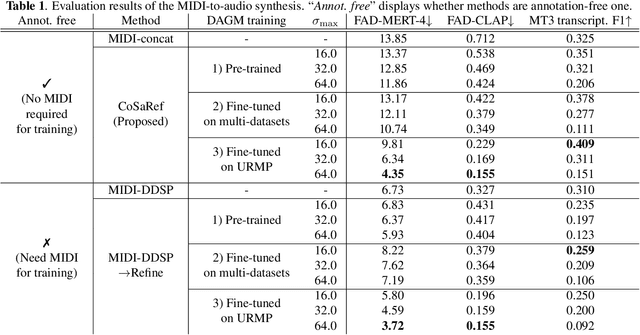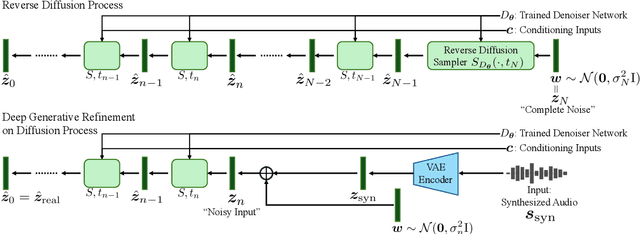Osamu Take
Annotation-Free MIDI-to-Audio Synthesis via Concatenative Synthesis and Generative Refinement
Oct 22, 2024


Abstract:Recent MIDI-to-audio synthesis methods have employed deep neural networks to successfully generate high-quality and expressive instrumental tracks. However, these methods require MIDI annotations for supervised training, limiting the diversity of the output audio in terms of instrument timbres, and expression styles. We propose CoSaRef, a MIDI-to-audio synthesis method that can be developed without MIDI-audio paired datasets. CoSaRef first performs concatenative synthesis based on MIDI inputs and then refines the resulting audio into realistic tracks using a diffusion-based deep generative model trained on audio-only datasets. This approach enhances the diversity of audio timbres and expression styles. It also allows for control over the output timbre based on audio sample selection, similar to traditional functions in digital audio workstations. Experiments show that while inherently capable of generating general tracks with high control over timbre, CoSaRef can also perform comparably to conventional methods in generating realistic audio.
SaSLaW: Dialogue Speech Corpus with Audio-visual Egocentric Information Toward Environment-adaptive Dialogue Speech Synthesis
Aug 13, 2024Abstract:This paper presents SaSLaW, a spontaneous dialogue speech corpus containing synchronous recordings of what speakers speak, listen to, and watch. Humans consider the diverse environmental factors and then control the features of their utterances in face-to-face voice communications. Spoken dialogue systems capable of this adaptation to these audio environments enable natural and seamless communications. SaSLaW was developed to model human-speech adjustment for audio environments via first-person audio-visual perceptions in spontaneous dialogues. We propose the construction methodology of SaSLaW and display the analysis result of the corpus. We additionally conducted an experiment to develop text-to-speech models using SaSLaW and evaluate their performance of adaptations to audio environments. The results indicate that models incorporating hearing-audio data output more plausible speech tailored to diverse audio environments than the vanilla text-to-speech model.
 Add to Chrome
Add to Chrome Add to Firefox
Add to Firefox Add to Edge
Add to Edge